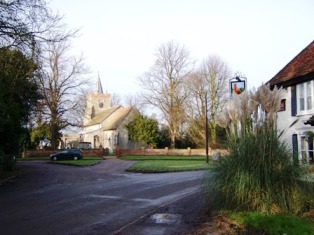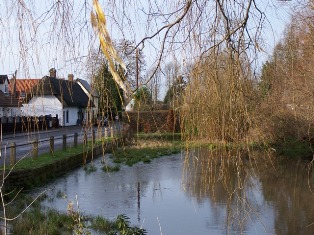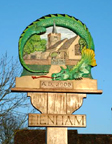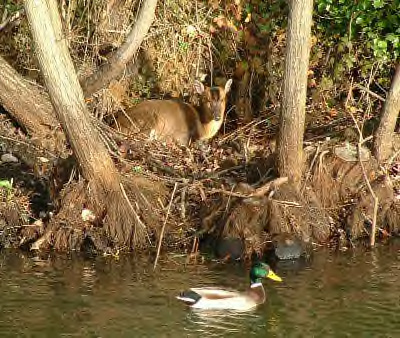The Parish of Henham consists
of Henham on the Hill, as it has been known in historical
documentation, and the two hamlets Little Henham and Pledgdon (sometime
known as Prison Green). Henham is the third highest point in
the county of Essex in England.  There is archaeological
evidence of human
habitation in Henham going back to the Roman period and even earlier to
the Neolithic Age.
There is archaeological
evidence of human
habitation in Henham going back to the Roman period and even earlier to
the Neolithic Age.
The earliest certain mention of Henham appears in the
Anglo- Saxon period. During that time we have the first written mention
of Henham in the tribal Hideage, drawn up in 626 AD under King Edwin
where the village is described as the little clearing on the top of the
hill emerged from the dark ages – ‘Hean’
meaning ‘high’ and ‘ham’
meaning ‘dwelling’. Henham and Plegdon together,
had cleared
land with tremendous effort from the surrounding forests, that would
have been about 2408 acres or a little more – no so different
from
today. There is a survival before our eyes of the Danish occupation.
The thatched roofs which are turned up at the ridge ends in a curious
‘neck’, are very strange and interesting survivals
of the dragon’s head
which was used by the Vikings and Danes to frighten away evil spirits
from sitting on the roof. Examples here are the Bury, all the
cottages
at Church End, and near the Church.
In the time of Edward the Confessor we get another mention of
Henham from the University Library at Cambridge. Henham
belonged
to Thurston, a great warrior, son of a Saxon earl and a loyal friend to
the King. The beginning of his will is particularly nice: -
“I, Thurston, Wine’s son, make known to
all men the
things which God has lent me, for as long as it shall be His
will”, and among his bequests, of gold to the king, two
war-horses and their trappings and armour, he left to his wife,
Aethelgyth, the estate at Henham, “except half a hide which
is to
go to the church”.
The Domesday Survey of 1086 reads at first like a lot of dull numbers,
but as one disentangles it, a shadowy picture of life emerges, and
reveals, for the Hall, a manor of about 1,610acres, worked by 18
villeins, or men who were not serfs, but who were not noble; 5 bordars,
or herdsmen, and 8 serfs or slaves, the lowest of the manor of whom it
was said, very terribly, “A slave is a thing, not a
person”. There were four teams or ploughs of 8 oxen, and 8
teams
of oxen of the homagers – men who would have made the old
Saxon
oath of fealty to Thurston or his wife Aethelgyth. There were always 16
acres of mead and enough wood for 100 swine – pigs were very
economical as they fed on acorns and nuts. There were three domestic
horses or ponies. Seven “beasts” or cows, non
–
ploughing cattle, cheaper at about 6d each than ploughing oxen. Sixteen
hives of bees, providing the only sugar, and much needed wax, for
candles and rushlights. The value of the manor in the
Confessor’s
time was £ 12 – in the Conqueror’s
£ 20. And
the sheep. 160 of them in King Edward’s time. Though we talk
of
the great “wool” churches of medieval East Anglia,
perhaps
we do not realize the sheep farming of England, and its great wealth,
was founded in Saxon times, when there were 7 ½ million
sheep,
three or four to every man woman and child. The Survey for Pledgedon or
Prison Hall manor, about 580 acres, shows little change under the
Conqueror. A greater proportion of meadow land than Henham, always
double the number of sheep, and fewer swine, showing less woodland.
Obviously a very scarcely populated manor, with only six hives of bees.
But perhaps at this time the 6 villeins and 16 bordars who are listed,
were piling up the moat and mound of a palisaded stronghold at Prison
Hall under Richard of Eudo, who held “Plicedana”.
The Survey of the Broom shows it to be small and very poor.
“Richard, a socman of Angar, held 1 hide, twenty acres in the
time of King Edward. Then 1 team, now none. Always 3 bordars, Wood for
20 swine”. Just as the new village organizations were being
brought into being, the physical shape of our village was being formed
too. More meadow land for grazing sheep was being cut from the
surrounding woods; moats dug for defence, and ponds for essential water
for man and beast; roads, showing today their origin, were being cut
from winding tracks and footpaths through the trees, and common land
and strip fields reclaimed according to the turn and width of the
plough. The new lords of the manor in Henham were the Fitzwalters,
living partly in London at Baynard’s Castle, but also, we are
fairly certain, in a fortified castle surrounded by a moat in Hall
Road. in King John’s reign we have the first mention of field
names in Henham, allied to those of householders. Aerial photographs of
Henham show how these strips have persisted right through to today.
Pressing on from the 17th century, we have a picture of a village much
less wealthy than in Tudor times. A very agricultural village, rather
backward in taking to new methods. We kept our artisans very late, the
sounds of the four blacksmiths at work, the seven carpenters, the
saddlers, and the twelve shoe-makers in six workshops – a
basket-maker, a tailor, dressmakers, and a wheelwright, and four
thatchers. The number of shoe-makers was probably accounted for as
there were two or more butchers, and a slaughter house. There was a
Boarding School for Young Ladies kept by Elizabeth Warner; at the
Vicarage there was a footman, a cook, a housemaid, a groom and an
agricultural labourer living in; there were three grocers, two
butchers, and a drapers. Later there was a Dame School at Apple Tree
Cottage. All this seems to indicate a Henham fairly buzzing with noise
and activity. There were chickens and geese being reared on the Greens.
The Census figures for 1851 shows that we had nine farms, large and
small. The Parsonage: Lodge Farm: Little Henham Lodge: Little Henham
Hall: Old Mead: the Broom: Pledgdon Hall: and Sandpits House. At
Pledgdon Green there were two smaller farms, George Orger’s
with
88 acres, and Joseph Haughton with 60. Henham Lodge was far the largest
with 466 acres, employing 24 men and 15 boys; Old Mead came second with
396 acres and 22 men, which shows us the difference in work on the land
before mechanization.
The break-up of the landed
estates, which saw the auctioning of properties between 1860 and 1922,
brought a rapid decline for men, women and children employed in
domestic service. The construction of the Elsenham - Thaxted
Railway in 1913 gave access to the mainline to London and Cambridge.
Post World War II mechanisation reduced the need for agricultural
workers and turned the area into a satellite
commuting village for the two cities. This line was closed in 1952 thus
contributing to the increase of cars in the village. There is little opportunity
for local employment and the lack of affordable housing for our young
people has forced them to move from their home village to more urban
areas of habitation.
Today our farms only require barely six men.




 There is archaeological
evidence of human
habitation in Henham going back to the Roman period and even earlier to
the Neolithic Age.
There is archaeological
evidence of human
habitation in Henham going back to the Roman period and even earlier to
the Neolithic Age.